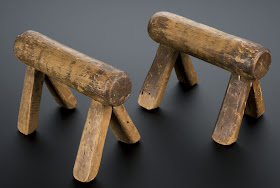- propels himself on a wheeled dolly. I suppose the eighteenth-century leper wouldn't even have had the benefit of a dolly.
Lower photo credit etherflyer.
Update: When I posted the above six months ago, I thought it was one-and-done, but today I encountered this image at Got Medieval:
It's an illustration from the fourteenth-century Bodleian Alexander (MS Bodl. 264), depicting "A gentleman’s dispute among disabled beggars." Carl Pyrdum notes at the post:
I feel compelled to point out–with some weird version of disciplinary pride?–that the medieval manuscript version of the theme boats three brawlin’ beggars to the cartoon’s two, a net improvement of fifty percent over South Park. And it’s way bloodier than they dared, to boot (which you can see more clearly if you click [the image at the source] to expand).I would add that the event pictured may not depict the social realities of the day, since the marginal illustrations sometimes reflected allegories or the whimsies of the artists rather than serving as frank documentary illustrations.
But it's something you don't see every day. Also interesting that the technology remained unchanged for four centuries.
Addendum: A hat tip to Got Medieval for some additional information. The small "trestles" that the men are supporting themselves on were called "scabella," and the men "scabellarii." They are "footless," and the upright man wielding the crutch has lost one foot as well.
I would presume these are victims of leprosy, but since their hands are intact, perhaps these are battle injuries, or even ?the result of ergot poisoning.



Something I didn't say clearly in the post you linked, but which might be interesting to someone interested in the actual physical artifacts, is that the two disabled beggars aren't just beggars, they're musicians. The things strapped to their lower legs were identified by the manuscript cataloger (who no doubt knows much more about such things than I) as scabella, percussion instruments that are apparently notoriously difficult to play.
ReplyDeleteSo this scene may in fact depict a brawl over busking space.
Thank you - I'll have to do a little research. A quick search just now did show "scabella" as sandal-like footwear used to make clapping noises. But it is also the plural of "scabellum" which is a "footstool", which looks more like the drawing.
ReplyDeleteI'll try to search a few antiquity-type sites and try to insert an addendum later.
I appreciate your input - it should make the post more interesting eventually. :.)
I'm back, without finding anything to support the cataloger's idea that these are "scabella = musical instruments."
ReplyDeleteI did find an image in this psalter -
http://blognoon.com/post.htm?post_id=449560
- with this explanatory text:
"This Psalter dates back to 1210. This page shows the beginning of Psalm 110 which begins:
"Dixit Dominus Domino meo sede a dextris meis donec ponam inimicos tuos scabellum pedum tuorum"
'The Lord said to my Lord, "Sit at my right hand while I make your enemies a footstool for your feet."
The large historiated initial "D" shows the Trinity seated in heaven. Inspired by the first verses of the psalm, Jesus sits at the right of God the Father, both with demons under their feet."
And after viewing the battling trio again, I don't see anything inherent in the image that identifies them as musicians (it may have been in accompanying text). But I do note that they display bandages on at least four of their six lower legs, and no feet on those legs. So I would presume them to be lepers - and more likely beggars than musicians.
My guess (and it's only that) is that the image was identified by someone as showing scabella in the sense of footstools, without explanation. Then a subsequent reader saw the word scabella and associated it with the clappers worn on the feet of Roman musicians.
For the moment I'll retain the presumption that the image shows footless beggars battling using their propulsion systems rather than musicians wielding their instruments.
We'll see what readers of this blog come up with in the next few days.
:.)
Looks like it's my mistake. And I so wanted it to be musicians, for there to be an extra level to the joke.
ReplyDeleteHere is the full catalog note on the scene:
three cripples fight each other: two are scabellarii (footless), and fight each other with their knee-stools, and the third, with one leg, joins in, hitting them with his crutch.
So maybe I should've said, the manuscript cataloger identifies the men as 'scabellarii', which I took as the plural for scabella player, scabellarii. When the OED failed me on the word, I turned to Google, where the first two pages of hits are all for the term used musically. But there on the third page is a JSTOR hit that clears it up:
"...on right there are two cripples holding up their hands. We see the small trestles (scabella) on which they supported their hands as they crept about--such cripples were called scabellarii."
Different scene, same term. My bad. At least I've got another new one for my personal wordhoard.
Thank you so much! I'll post an amendment tomorrow.
ReplyDeleteThese crutches can also be seen on "Saint Martin in the harbor" and A Saint leaves the city" by anonymous Bosch followers (in the former case in combination with a harp-like instrument).
ReplyDeleteThank you, Marcel. I wasn't able to locate an image of that painting this morning, but while searching, I did find one of "Saint Martin and the Beggar" -
ReplyDeletehttp://www.niceartgallery.com/Hungarian-Unknown-Masters/Saint-Martin-and-the-Beggar-%282%29-c-1490.html
- which showed the devices in use.
The print of St Martin in the harbor was published by Hieronymus Cock. With his name you will be able to find it on http://educators.mfa.org/
ReplyDeleteThe beggars with those crutches (and one with a dolly!) are on the left and left bottom corner.
Found it -
ReplyDeletehttp://educators.mfa.org/objects/detail/246815?keyword=Hieronymus+Cock&page=1
Thank you.